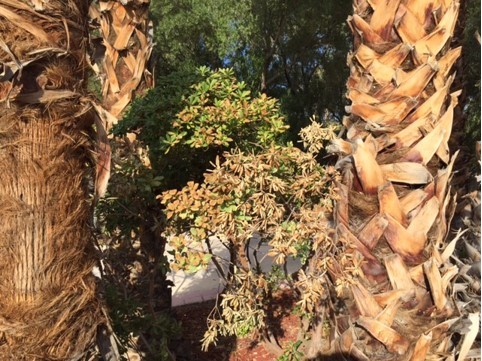Q. A combination of
overwatering and this heat caused my 9-year-old dwarf pomegranate leaves to yellow
and drop on about 1/3 of the plant. I
turned off the water and hand watering it with small amounts of water. The only
thing I did differently was give the plants a small dose of MiracleGro in the
spring. Any suggestions?
A. This is not your common ordinary disease problem. It is humanitis! And the fertilizer did not cause it either.
Pomegranate is remarkably resilient in our climate if it’s not watered too often. Avoid watering these plants daily. Give it plenty of water when you irrigate and then hold off until the next irrigation. I water newly planted trees this spring every other day when temperatures are above 110° F.
Watering once a week is enough in early spring and late fall. As it gets warmer, water more often. You should never have to water more than once every other day in the hottest weather!
Pomegranate is remarkably resilient in our climate if it’s not watered too often. Avoid watering these plants daily. Give it plenty of water when you irrigate and then hold off until the next irrigation. I water newly planted trees this spring every other day when temperatures are above 110° F.
 |
| Here's a pomegranate yellowing. Why? Because it was planted in a lawn that needs watering every day. |
Watering once a week is enough in early spring and late fall. As it gets warmer, water more often. You should never have to water more than once every other day in the hottest weather!
Leaf yellowing and drop can be a temporary problem with
many fruit trees regarding water issues. Give the plant some time to respond if
these branches are still supple and bend easily.
If these branches have dried and appeared dead, cut them
off just above healthy growth. I have removed damaged parts during the summer
months and the plant re-grew without problems.
Use wood chip mulch on the soil surface to help preserve
soil moisture during the heat. This gives me one extra day between waterings. I
am giving new plants about 5 gallons, 3-year-old trees about 10 gallons,
5-year-old trees about 15 gallons and trees over 8 years old from 20 to 30
gallons depending on their size. A dwarf, 9-year-old tree is going to be in the
range of 10 to 15 gallons each time you water.
I have had no problems
with loss of leaves during the summer but some of the 20+ varieties I have
grown had winter cold damage. Some varieties of pomegranates, particularly
those with Russian names, showed some winter cold damage. Older, common
varieties sold for many years in the American market sailed through cold
winters down to 10° F.











